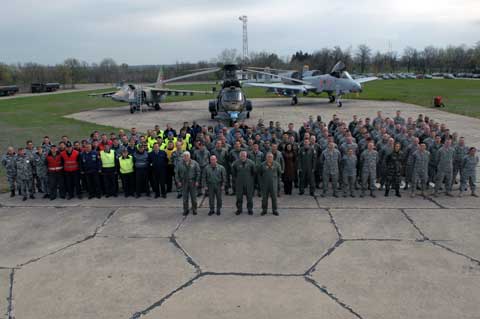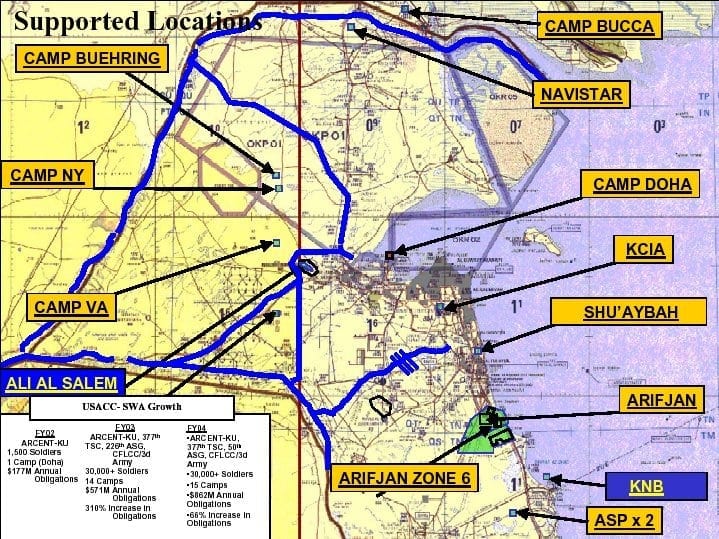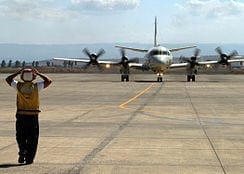What Are Foreign Military Bases For?
David Swanson, Washington’s Blog

US soldiers in forward base in Afghanistan receive fuel supplies by air. (Click on images to expand)
[dropcap]I[/dropcap]f you’re like most people in the United States, you have a vague awareness that the U.S. military keeps lots of troops permanently stationed on foreign bases around the world. But have you ever wondered and really investigated to find out how many, and where exactly, and at what cost, and to what purpose, and in terms of what relationship with the host nations?
A wonderfully researched new book, six years in the works, answers these questions in a manner you’ll find engaging whether you’ve ever asked them or not. It’s called Base Nation: How U.S. Military Bases Harm America and the World, by David Vine.
Some 800 bases with hundreds of thousands of troops in some 70 nations, plus all kinds of other “trainers” and “non-permanent” exercises that last indefinitely, maintain an ongoing U.S. military presence around the world for a price tag of at least $100 billion a year.
Why they do this is a harder question to answer.
Even if you think there is some reason to be able to quickly deploy thousands of U.S. troops to any spot on earth, airplanes now make that as easily done from the United States as from Korea or Japan or Germany or Italy.
View of the Bezmer air force base, in Bulgaria, a typical case.

“A Bulgarian air force SU-25 Frogfoot aircraft taxis past a U.S. Air Force C-130E Hercules aircraft at Bezmer Aviation Base, Bulgaria, March 31, 2008, prior to flying a sortie for exercise Thracian Spring 2008. The annual bilateral training exercise between the United States and Bulgaria provides training and improves interoperability between the two nations. (U.S. Air Force photo by Master Sgt. Scott Wagers) (Released)”
)
[learn_more]
 Today the Bulgaria Bezmer base is taking part in number of joint training exercises such as PfP (partnership for peace) (sic), which is a NATO program designed to create an environment of peace among NATO nations. The program comprises of countries (sic) such as Bulgaria, Turkey, France and more. The base offers its services and provides support to NATO programs. The base also offered its services in other joint programs such as Immediate Response 2006, which was held between United States and Bulgaria.
Today the Bulgaria Bezmer base is taking part in number of joint training exercises such as PfP (partnership for peace) (sic), which is a NATO program designed to create an environment of peace among NATO nations. The program comprises of countries (sic) such as Bulgaria, Turkey, France and more. The base offers its services and provides support to NATO programs. The base also offered its services in other joint programs such as Immediate Response 2006, which was held between United States and Bulgaria.
To coop with international joint operations, the base is installed with new technological navigational and communication systems. There also plans (sic) to expand the range of the base to support planes at longer distances. The base is also ranked among the best bases in the world where US Forces are stationed, and it receives great importance by US Forces. [/learn_more]
[dropcap]I[/dropcap]t costs dramatically more to keep troops in those other countries, and while some base defenders make a case for economic philanthropy, the evidence is that local economies actually benefit little — and suffer little when a base leaves. Neither does the U.S. economy benefit, of course. Rather, certain privileged contractors benefit, along with those politicians whose campaigns they fund. And if you think military spending is unaccountable at home, you should check out bases abroad where it’s none too rare to have security guards employed purely to guard cooks whose sole job is to feed the security guards. The military has a term for any common SNAFU, and the term for this one is “self-licking ice cream.”

SUBIC BAY, The Philippines. One of the oldest imperial military outposts. The nuclear-powered aircraft carrier USS ENTERPRISE (CVN-65) is in the foreground.
The bases, in many cases, generate an enormous amount of popular resentment and hatred, serving as motivations for attacks on the bases themselves or elsewhere — famously including the attacks of September 11, 2001.
Bases around the borders of Russia and China are generating new hostility and arms races, and even proposals by Russia and China to open foreign bases of their own. Currently all non-U.S. foreign bases in the world total no more than 30, with most of those belonging to close U.S. allies, and not a single one of them being in or anywhere near the United States, which would of course be considered an outrage.
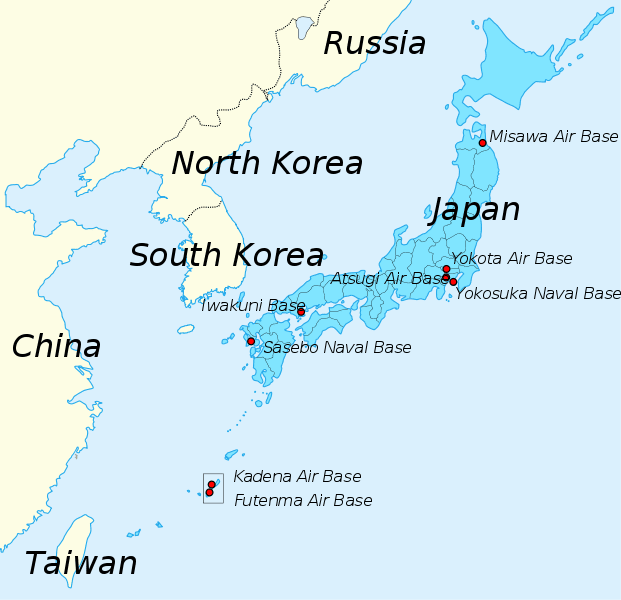
US military bases in Japan: the strategic importance to Washington, to be a “stone’s throw” from the mainland, is obvious.
Many U.S. bases are hosted by brutal dictatorships. An academic study has identified a strong U.S. tendency to defend dictatorships where the United States has bases. A glance at a newspaper will tell you the same. Crimes in Bahrain are not equal to crimes in Iran. In fact, when brutal and undemocratic governments currently hosting U.S. bases (in, for example, Honduras, Aruba, Curaçao, Mauritania, Liberia, Niger, Burkina Faso, Central African Republic, Chad, Egypt, Mozambique, Burundi, Kenya, Uganda, Ethiopia, Djibouti, Yemen, Qatar, Oman, UAE, Bahrain, Saudi Arabia, Kuwait, Jordan, Israel, Turkey, Georgia, Afghanistan, Pakistan, Thailand, Cambodia, or Singapore) are protested, there is a pattern of increased U.S. support for the government, which makes eviction of the U.S. bases all the more likely should the government fall, which fuels a vicious cycle that increases popular resentment of the U.S. government. The U.S. began building new bases in Honduras shortly after the 2009 coup.
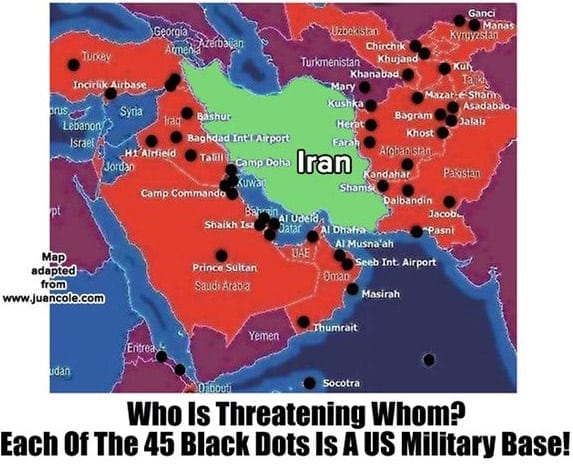
US bases encircling Iran. These bases were there long before the latest tumult about Iran’s “nuclear ambitions”, a manufactured issue.
Vine also tells a troubling story of the U.S. military’s alliance with the Camorra (the mafia) in Naples, Italy, a relationship that has lasted from World War II to the present, and which fueled the rise of the Camorra — a group reportedly deemed reliable enough by the U.S. military to protect nuclear weapons.
The smaller bases that don’t house tens of thousands of troops, but secretive death squads or drones, have a tendency to make wars more likely. The drone war on Yemen that was labeled a success by President Obama last year has helped fuel a larger war.
In fact, I want to quibble with Vine’s account of the birth of Base Nation, because I think the facilitation of the worst war ever was involved. Vine gives the history of the U.S. bases in Native American lands, starting in 1785 and very much alive today in the language of U.S. troops abroad in “Indian territory.” But then Vine dates the birth of the modern base empire to September 2, 1940, when President Franklin Roosevelt traded Britain old ships in exchange for various Caribbean, Bermudan, and Canadian bases to be used in or after the war he was supposedly not planning on. But I’d like to back the clock up a little.
When FDR visited Pearl Harbor (not actually part of the United States) on July 28, 1934, the Japanese military expressed apprehension. General Kunishiga Tanaka wrote in the Japan Advertiser, objecting to the build-up of the American fleet and the creation of additional bases in Alaska and the Aleutian Islands (also not part of the United States): “Such insolent behavior makes us most suspicious. It makes us think a major disturbance is purposely being encouraged in the Pacific. This is greatly regretted.”
Then, in March 1935, Roosevelt bestowed Wake Island on the U.S. Navy and gave Pan Am Airways a permit to build runways on Wake Island, Midway Island, and Guam. Japanese military commanders announced that they were disturbed and viewed these runways as a threat. So did peace activists in the United States. By the next month, Roosevelt had planned war games and maneuvers near the Aleutian Islands and Midway Island. By the following month, peace activists were marching in New York advocating friendship with Japan. Norman Thomas wrote in 1935: “The Man from Mars who saw how men suffered in the last war and how frantically they are preparing for the next war, which they know will be worse, would come to the conclusion that he was looking at the denizens of a lunatic asylum.” The Japanese attacked Wake Island four days after attacking Pearl Harbor.
 In any case, Vine points to the uniqueness of World War II as a war that has never been ended, even after the Cold War was said to have ended. Why have the troops never come home? Why have they continued to spread their forts into “Indian Territory,” until the U.S. has more foreign bases than any other empire in history, even as the era of conquering territory has ended, even as a significant segment of the population has ceased thinking of “Indians” and other foreigners as subhuman beasts without rights worthy of respecting?
In any case, Vine points to the uniqueness of World War II as a war that has never been ended, even after the Cold War was said to have ended. Why have the troops never come home? Why have they continued to spread their forts into “Indian Territory,” until the U.S. has more foreign bases than any other empire in history, even as the era of conquering territory has ended, even as a significant segment of the population has ceased thinking of “Indians” and other foreigners as subhuman beasts without rights worthy of respecting?
One reason, well-documented by Vine, is the same reason that the huge U.S. base at Guantanamo, Cuba, is used to imprison people without trials. By preparing for wars in foreign locations, the U.S. is often able to evade all kinds of legal restrictions — including on labor and the environment, not to mention prostitution. GIs occupying Germany referred to rape as “liberating a blonde,” and the sexual disaster area surrounding U.S. bases has continued to this day, despite the decision in 1945 to start sending families to live with soldiers — a policy that now includes shipping each soldier’s entire worldly possessions including automobiles around the world with them, not to mention providing single-payer healthcare and twice the spending on schooling as the national average back home. Prostitutes serving U.S. bases in South Korea and elsewhere are often virtually slaves. The Philippines, which has had U.S. “help” as long as anyone, provides the most contractor staff for U.S. bases, cooking , cleaning, and everything else — as well as likely the most prostitutes imported to other countries, like South Korea.

The US Navy in Busan, Republic of Korea. South Korea is —despite a sizable army of its own and far greater population—officially regarded as too weak to face the North. Hence the permanent presence of the US military.
The most isolated and lawless base sites include locations from which the U.S. military evicted the local population. These include bases in Diego Garcia, Greenland, Alaska, Hawaii, Panama, Puerto Rico, the Marshall Islands, Guam, the Philippines, Okinawa, and South Korea — with people evicted as recently as 2006 in South Korea.
In hundreds of other sites where the population was not evicted, it might wish it had been. Foreign bases have been environmentally disastrous. Open-air burns, unexploded weaponry, poisons leaked into the ground water — these are all commonplace. A jet fuel leak at Kirkland Air Force Base in Albuquerque, N.M., started in 1953 and was discovered in 1999, and was more than twice the size of the Exxon Valdez spill. U.S. bases within the United States have been environmentally devastating, but not on the scale of those in some foreign lands. A plane taking off from Diego Garcia to bomb Afghanistan in 2001 crashed and sank to the bottom of the ocean with some 85 hundred-pound munitions. Even ordinary base life takes a toll; U.S. troops produce over three times the garbage each as local residents in, for example, Okinawa.
Disregard for people and the land and the sea is built into the very idea of foreign bases. The United States would never tolerate another nation’s base within its borders, yet imposes them on Okinawans, South Koreans, Italians, Filipinos, Iraqis, and others despite huge protest. Vine took some of his students to meet with an official at the U.S. State Department, Kevin Maher, who explained to them that U.S. bases in Japan were concentrated in Okinawa because it was “the Puerto Rico of Japan” where people have “darker skin,” are “shorter,” and have an “accent.”
Base Nation is a book that should be read — and its maps seen — by everyone. I wish Vine did not write “Russia’s seizure of Crimea” when referring to a free and open and legal vote, especially in the context of a book about military bases. And I wish he did not only use selfish points of reference in terms of financial tradeoffs. Of course the United States could be transformed for the better with the redirection of military spending, but the United States and the world both could be. It’s that much money.
But this book will be an invaluable resource for years to come. It also includes, I should note, an excellent account of some of the resistance struggles that have in some cases shut bases down or scaled them back. It’s worth noting that just this week, in the first of two necessary rulings, an Italian court has ruled for the people, against the U.S. Navy’s construction of communications equipment in Sicily.
Just this month, the U.S. Joint Chiefs of Staff published “The National Military Strategy of the United States of America — 2015.” It gave as justification for militarism lies about four countries, beginning with Russia, which it accused of “using force to achieve its goals,” something the Pentagon would never do! Next it lied that Iran was “pursuing” nuclear weapons, a claim for which there is no evidence. Next it claimed that North Korea’s nukes would someday “threaten the U.S. homeland.” Finally, it asserted that China was “adding tension to the Asia-Pacific region.” This “Strategy” admitted that none of the four nations wanted war with the United States. “Nonetheless, they each pose serious security concerns,” it said.
So, one might add, does each of the U.S. foreign bases. Vine’s book ends with some excellent proposals for change, to which I would add only one: Smedley Butler’s proposed rule that the U.S. military be forbidden to travel more than 200 miles from the United States.
David Vine is this week’s guest on Talk Nation Radio.
Read More @ Washington’s Blog.com
ADDENDUM
(1) The following excerpt explains the demonstrations near Sigonella and Niscemi AFB in Sicily. It was written by Italian left militants for the website remilitant.eu, so it has its own idiosyncratic way of telling the story.
MUOS: protests in Sicily against this U.S. instrument of war
On January 26, 2014 the US Navy completed the construction of the MUOS (Mobile User Objective System) situated in Niscemi, Sicily just at 3 km from the town.
The Muos allow the U.S. to control a range of weapons and then kill thousands of people with a click from a comfortable armchair in Washington.
The structure stands in the middle of a nature reserve where there is an absolute prohibition of construction and has already destroyed 5,000 square meters of cork of great natural interest.
The base is located a few kilometers from the town of Niscemi for which the effects of electromagnetic waves emitted will lead to many serious diseases.
At 50 Km from the US base of Niscemi there is the Sigonella US Navy base, one of the largest and most active in the Mediterranean, and the military port of Augusta: in these places there are also drones and nuclear weapons.
For these reasons from about two years the local population is protesting against all the military bases in Sicily and in Italy. Every day dozens of people congregate in front of the Niscemi base to protest. A few months ago thousands of people entered into the base and climbed the NRTF antennas. These antennas were installed many years ago and are really harmful to the health of the locals (as proved by the Italian environmental agency -ARPA-).
We are against the US imperialism!
ABOUT THE AUTHOR
[printfriendly]
Remember: All captions and pullquotes are furnished by the editors, NOT the author(s).
What is $5 a month to support one of the greatest publications on the Left?
